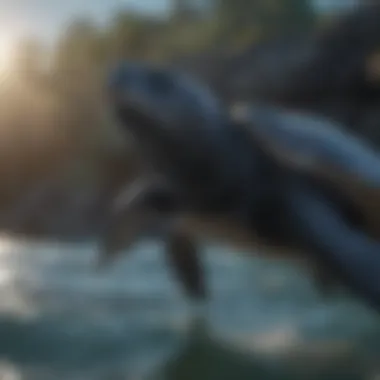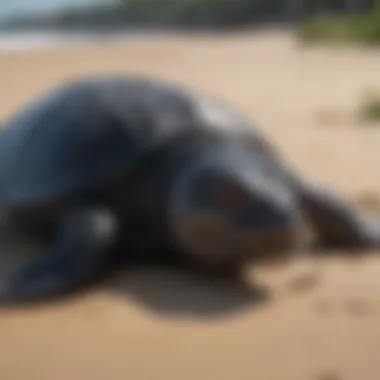Protecting the Endangered Leatherback Turtles


Nature Topic Overview
Leatherback turtles are one of the largest and most remarkable sea turtles in the world. Their body can weigh up to 2,000 pounds and reach lengths of about 6.5 feet. Unlike other sea turtles, leatherbacks do not have a hard shell. Instead, their back is covered with a thick, leathery skin, which gives them their name. These turtles are known for their long migrations, traveling thousands of miles between feeding and nesting grounds. However, their population is in decline due to several pressing threats.
Key Threats to Leatherback Turtles
Leatherback turtles face various dangers that contribute to their endangered status. Some of these include:
- Bycatch in Fishing Gear: Many leatherbacks are accidentally caught in fishing nets and gear meant for other species. This often leads to injury or death.
- Coastal Development: As humans build along coastlines, nesting beaches become limited. This destruction impacts where leatherbacks can lay their eggs.
- Pollution: Plastic pollution poses a significant threat. Leatherbacks often mistake plastic bags for jellyfish, which can lead to fatal ingestion.
- Climate Change: Rising sea temperatures and changes in ocean currents affect food availability and nesting success.
Understanding these threats is crucial in developing strategies for conservation.
"The survival of the leatherback turtle is linked to the health of our oceans."
Fun Facts and Trivia
Leatherback turtles are fascinating creatures. Here are some fun facts:
- They can dive deeper than any other turtle, plunging to depths over 4,000 feet.
- Unlike other sea turtles, leatherbacks eat primarily jellyfish, which they locate using specialized sensory organs.
- The leatherback's body is unique; it can maintain a warmer body temperature than the surrounding water.
These interesting facts not only inform but can also spark curiosity among young readers, encouraging them to learn more.
Wildlife Explorations
The leatherback turtle is part of a diverse ecosystem. Other related marine species include:
- Loggerhead Sea Turtles: Similar in size but with a harder shell.
- Jellyfish: Main food source for leatherbacks.
- Seabirds: These birds often feed near turtle nesting sites and help control outside predators.
Exploring these connections helps us appreciate the delicate balance of marine life.
Environmental Awareness
Conservation of the leatherback turtle requires a collective effort. Children can play a role in protecting marine life. Here are some actions they can take:
- Reduce plastic use and promote recycling.
- Participate in beach cleanups to help remove trash from nesting beaches.
- Educate others about the importance of conserving sea turtles.
Engaging children in these activities fosters their sense of responsibility towards nature.
DIY Nature Activities
Hands-on learning can enhance a child’s understanding of the importance of nature. Here are some DIY activities:
- Craft a Collage: Use recycled materials to create a collage that represents oceans and sea life.
- Jellyfish Jars: Fill mason jars with water, blue food coloring, and glow-in-the-dark jellyfish decorations to simulate the marine habitat.
- Beach Scavenger Hunt: Organize a scavenger hunt to find local items related to marine life (like seashells or plastic trash).
These simple activities promote creativity and environmental awareness, helping children connect with the ocean in meaningful ways.
Understanding Leatherback Turtles
Understanding leatherback turtles is crucial in addressing the ongoing issues that threaten their survival. These magnificent creatures are not just icons of marine life but also play important roles in their ecosystems. By studying their biology, behavior, and habitats, we can appreciate the complexity of their existence and the various factors impacting them. This section serves as the foundation for our discussion about the endangerment of leatherback turtles, delving into their species characteristics and natural habitats.
Species Overview
Leatherback turtles, known scientifically as Dermochelys coriacea, are the largest species of sea turtles. They can grow up to 2.9 meters in length and weigh as much as 700 kilograms. Unlike other turtles, they lack a rigid shell. Instead, they feature a soft, leathery skin, which aids in flexibility and buoyancy.
Leatherbacks are unique because of their deep-diving capabilities, being able to dive to depths exceeding 1,200 meters in search of jellyfish, their primary food source. These turtles are highly migratory, with some individuals traveling thousands of kilometers between feeding and nesting sites.
The color of a leatherback turtle's body is typically black, with some white or yellow spots. Their distinct physical traits synthesize their adaptations to a life spent predominantly in open ocean waters. Hence, understanding these traits is vital in conserving their populations.


Natural Habitat
Leatherback turtles inhabit a variety of marine environments, ranging from tropical to temperate waters. They are found in all major oceans, including the Atlantic, Pacific, and Indian Oceans. Leatherbacks are particularly drawn to areas with abundant jellyfish, such as coastal regions and areas where ocean currents converge.
These turtles often migrate between feeding areas and nesting beaches. Nesting usually occurs in tropical regions, on sandy beaches, where females lay about 80 to 100 eggs. These eggs are crucial for the continuation of their species.
The natural habitat of the leatherback turtle is at risk due to human activities. Coastal development, pollution, and global warming are factors that manipulate their environment, forcing these turtles into more dangerous waters. Protecting these habitats is essential for the survival of leatherbacks, and understanding their preferred environments helps conservationists create effective strategies.
"Leatherback turtles are not only a unique species, but they also connect us with the broader marine ecosystem. Their decline can signal larger issues at play in the ocean."
In summary, understanding leatherback turtles is a vital component of conservation efforts. Awareness of their species traits and natural habitats helps to inform and enhance strategies designed to protect them for generations to come.
Population Status of Leatherback Turtles
Understanding the population status of leatherback turtles is crucial for several reasons. Leatherbacks are among the most magnificent sea creatures, but their numbers are waning. Knowing how many exist can guide conservation strategies. It also helps raise awareness about the threats these turtles face. Tracking population changes shows us how effective conservation efforts are. This section explores current estimates and historical trends, giving a comprehensive view of the leatherback turtle's plight.
Current Population Estimates
The current population of leatherback turtles is a cause for concern. As of recent estimates, the global population stands between 34,000 and 70,000 adult individuals. This wide range highlights the uncertainty in accurate counting of these elusive creatures. Researchers face numerous challenges when trying to track them due to their migratory habits. They travel long distances across oceans which makes sighting difficult.
In the Pacific Ocean, the population is especially low. For instance, studies show that nesting sites in places like California and Mexico have drastically reduced. Here, nesting females are estimated to be around just a few thousand. In contrast, the Atlantic Ocean has better conditions, but still faces threats from human activity.
It is key to monitor these population numbers constantly. These figures motivate efforts in conservation.
Historical Population Trends
Historically, the leatherback turtle population was much higher. Reports indicate that from the mid-20th century, their numbers began to decline rapidly. Factors like hunting for their meat, egg collection, and habitat destruction played significant roles in this decline.
In the past, it is believed that millions of leatherbacks roamed the oceans. However, studies show that many nesting sites have seen over a 90% decline in numbers. From 1980 to 2000, the number of nesting females in some areas dropped dramatically. The Caribbean region is particularly affected, where local populations have not recovered.
As time has passed, it's evident that actions taken today will determine their future. Continued monitoring and research on these historical trends are necessary. This knowledge shapes conservation strategies aimed at reversing the decline.
In sum, both current estimates and historical trends illustrate a clear and concerning trajectory for leatherback turtles. Their survival depends not only on understanding these figures but also on taking effective action to protect them.
Key Threats to Leatherback Turtles
The survival of leatherback turtles depends on diverse environmental and human factors. Understanding these threats is essential for anyone interested in marine conservation. It lays a foundation for recognizing how these challenges interconnect and affect the existence of this magnificent species. Each threat mentioned below has a significant impact on the turtle's population and highlights the urgent need for protective measures.
Habitat Destruction
Habitat destruction primarily occurs due to coastal development. Beaches are often altered for building homes, hotels, or other infrastructures. This process damages nesting grounds where female leatherbacks lay their eggs. Increased urbanization leads to increased light pollution, which disorients hatchlings trying to find their way to the ocean. Without suitable nesting habitats, leatherback populations face severe decline.
Moreover, the degradation of marine environments like coral reefs and seagrass beds threatens the leatherbacks' foraging grounds. These areas are vital, as they provide food sources such as jellyfish, which make up a significant part of their diet. Losing access to these habitats can negatively affect their growth and reproduction rates.
Pollution and Debris
Pollution poses a severe threat to leatherback turtles. Commonly found marine debris, particularly plastic, causes harm in various ways. Turtles often mistake plastic bags for jellyfish. When ingested, it can lead to internal injuries, malnutrition, or even death. Oil spills and chemical pollutants also compromise their health by contaminating their food sources and habitats.
In addition to physical debris, pollutants in the water can disrupt the endocrine systems of leatherbacks, leading to reproductive issues. The long-term effects of such contamination can be devastating, as they affect the entire population's stability. Tackling pollution is not just an environmental necessity; it is crucial for the future survival of leatherback turtles.
Climate Change
Climate change introduces new challenges for leatherback turtles. Rising sea levels threaten their nesting habitats by eroding beaches, making them unfit for laying eggs. Warmer ocean temperatures can alter the distribution of jellyfish, which could impact the turtles' ability to find food. Furthermore, as temperatures increase, more female turtles are born due to temperature-dependent sex determination. This imbalance could lead to a decrease in genetic diversity and higher mortality rates in the future.
Extreme weather events, such as hurricanes, further jeopardize nesting success. Flooding can wash away nests and young turtles. Addressing climate change is vital for ensuring a sustainable future for leatherbacks and other marine species.
Illegal Fishing Practices
Illegal fishing practices greatly endanger leatherback turtles. Activities such as fishing with harmful nets lead to accidental captures known as bycatch. Turtles get trapped and cannot surface for air, resulting in drowning. Such practices not only harm the leatherbacks but also threaten the overall health of the marine ecosystem.


In some regions, poaching of eggs occurs due to demand for turtle eggs as food. This illegal trade diminishes the population, making it harder for the species to maintain stability. Robust regulations and enforcement are necessary to protect leatherbacks from these threats and ensure their survival in the wild.
"Without concerted global efforts to mitigate threats, the future of leatherback turtles remains uncertain."
Addressing these key threats is crucial for their preservation and requires the cooperation of governments, communities, and individuals alike.
Impact of Bycatch
Understanding Bycatch
Bycatch can include turtles, birds, and other sea creatures that get caught while fishers pursue their intended catch. Trawling and longlining methods are especially problematic. These techniques are often used in commercial fishing. Trawlers drag large nets across the ocean floor, while longliners utilize a long line with many hooks. Unfortunately, leatherback turtles may mistake the hooks for jellyfish, their primary food source. When they attempt to feed, they can get trapped, leading to injury or death.
Effective management of bycatch is vital for the conservation of leatherback turtles. Solutions may include using specialized gear that minimizes turtle capture, implementing monitoring systems, and enforcing regulations that protect these animals during their migratory routes.
Effects on Leatherback Populations
The impact of bycatch on leatherback populations is profound. Every individual turtle that is caught accidentally reduces the overall population. When fishing activities increase in areas crucial to leatherbacks, the risks multiply. It is not just about the number of turtles captured; it also affects breeding. The loss of adult females can disrupt population recovery efforts.
"Reducing bycatch is crucial for the survival of leatherback turtles, as each loss has a ripple effect on population stability."
Key points to consider regarding the effects of bycatch include:
- Loss of reproductive adults adversely affects future generations of leatherbacks.
- Increased vulnerability due to declining populations can lead to lower genetic diversity.
- Fishery management practices must adapt to mitigate the risks associated with bycatch.
In summary, bycatch directly influences the survival rates of leatherback turtles. Addressing this issue is essential for ensuring that these ancient mariners continue to grace our oceans for generations to come.
Conservation Efforts
Conservation efforts are vital in protecting leatherback turtles. This section sheds light on various actions taken to ensure these magnificent creatures survive and thrive in their natural habitat. Leatherback turtles face many threats, including habitat destruction, pollution, and climate change. To counter these dangers, a focused approach is necessary.
Current Conservation Strategies
Current conservation strategies encompass a range of initiatives designed to minimize the impacts on leatherback turtles. These strategies include:
- Marine Protected Areas (MPAs): These zones restrict fishing and other activities, allowing leatherbacks to thrive without disturbance.
- Nest Protection Programs: Such programs work to safeguard nesting sites, especially on beaches where human activities can lead to egg destruction.
- Monitoring Programs: Collecting data on nesting behaviors and population trends helps scientists make informed decisions regarding conservation.
- Rescue and Rehabilitation: Some stranded or injured turtles receive medical attention, giving them a chance to return to the wild.
Implementing these strategies effectively requires collaboration among governments, non-profit organizations, and local communities.
International Regulations
International regulations play an important role in leatherback conservation. Global agreements and treaties seek to protect turtles across their migratory routes.
- Convention on International Trade in Endangered Species (CITES): This agreement ensures that international trade does not threaten leatherback populations.
- Inter-American Convention for the Protection and Conservation of Sea Turtles: This treaty focuses on the protection of sea turtles in the Americas, promoting collaboration between countries.
- Regional Fisheries Management Organizations (RFMOs): These organizations regulate fishing practices, reducing bycatch that affects leatherback turtles.
Such regulations increase awareness and compel countries to take action against illegal fishing and habitat destruction.
Community Involvement
Community involvement is crucial for effective conservation efforts. Engaging local populations raises awareness about the importance of protecting leatherbacks. Ways communities can get involved include:
- Educational Workshops: Programs can teach children and adults about the threats leatherbacks face, fostering a sense of responsibility.
- Beach Clean-ups: Organizing events to remove debris not only protects nesting sites but also promotes community spirit.
- Citizen Science Projects: Local individuals can participate in data collection, contributing valuable information to researchers.
- Advocacy Campaigns: Encouraging communities to advocate for stronger protections can influence local policies.
"Every action, no matter how small, contributes to a larger effort to save leatherback turtles."
Involving communities in these efforts creates a grassroots movement, generating lasting positive change for leatherback turtles.
Role of Education in Conservation


Education plays a crucial role in the conservation of leatherback turtles. Understanding the challenges these majestic creatures face is essential. Education helps raise awareness among different audiences, particularly kids and their families. By promoting knowledge of conservation issues, we empower communities to take action toward protecting leatherbacks.
One important element of education is the dissemination of accurate and engaging information. This ensures that the message about the threats to leatherbacks is clear. Teaching about their biology, habitat, and migratory patterns can inspire interest and concern. By fostering an emotional connection, learners are likely to become advocates for these turtles.
Furthermore, education can bridge the gap between science and the general public. It can make scientific findings accessible and relevant. When people understand the consequences of plastic pollution or climate change, they may be more inclined to support conservation measures. Education fosters a sense of responsibility and encourages environmentally friendly practices within communities.
Importance of Awareness
Awareness is the first step toward conservation. Without knowledge, it is difficult to inspire action. When people understand that leatherback turtles are endangered, they might reconsider their habits. For instance, reducing plastic use can directly lessen ocean pollution, a major threat to turtle survival.
Awareness initiatives can take various forms. Social media campaigns, school presentations, and community workshops can all be effective. Engaging visuals and storytelling can captivate audiences, conveying the urgency of the issue. The goal is to instill a sense of stewardship for ocean life and its inhabitants.
"An informed public is the strongest ally for conservationists."
Educational Programs
Educational programs serve as a powerful tool in promoting conservation. Schools and organizations can implement curricula focused on marine biology, ecology, and conservation practices. Such programs can educate children about leatherback turtles, enabling them to become informed advocates.
Various organizations run programs aimed at children's engagement with the environment. Activities could include:
- Interactive lessons about the lifecycle of leatherback turtles
- Field trips to marine reserves
- Art projects focusing on ocean conservation
Partnerships between schools and conservation groups can enhance these educational efforts. By working together, they can create resources that are not only informative but also fun for kids and their families.
Effective educational programs also prepare children to become future leaders. When they understand the importance of conservation, they are more likely to pursue related careers. These roles can include marine biologists, environmental scientists, and policy makers dedicated to ocean protection.
Future Outlook for Leatherback Turtles
The future of leatherback turtles is a topic that requires careful consideration. Their survival depends on a combination of effective conservation efforts, public awareness, and the implementation of policies that address threats to their existence. Understanding the potential recovery scenarios for these turtles can provide hope but also highlights the challenges they face ahead.
Potential Recovery Scenarios
The recovery of leatherback turtle populations is possible through committed conservation actions. Here are several potential scenarios that can lead to improvement in their numbers:
- Habitat Protection: Establishing marine protected areas can help preserve key habitats where leatherbacks feed and nest. These locations offer safety from fishing and development that can harm these turtles.
- Monitoring Programs: Implementing rigorous monitoring of turtle populations can provide valuable data. This information can help scientists understand trends and make informed decisions about future conservation efforts.
- Community Engagement: Involving local communities in conservation initiatives can be beneficial. When people understand the importance of leatherbacks, they're more likely to support protective measures. Local education can motivate people to take action to preserve the species.
"The conservation of leatherback turtles requires action at many levels, from global policies to local community efforts."
- Research and Technology: Advancements in technology can improve conservation strategies. For example, satellite tracking can provide insights into migration patterns, assisting in the identification of crucial areas for protection.
Challenges Ahead
Despite the positive potential recovery scenarios, several challenges pose significant threats to leatherback turtles. Some key challenges include:
- Continued Habitat Loss: Coastal development continues to threaten nesting beaches. If more nesting areas are lost, it will severely impact leatherback reproduction.
- Climate Change: Rising ocean temperatures affect the turtles' food supply, and changing weather patterns can lead to more flooding of nests, reducing hatching success.
- Pollution: Ocean pollution, especially plastic waste, remains a critical issue. Leatherbacks often ingest plastic, mistaking it for food, which can lead to injury or death.
- Illegal Fishing: Some fishing practices remain illegal. Even with regulations, illegal fishing continues to impact leatherback populations due to bycatch.
Addressing these challenges requires a coordinated effort among governments, non-governmental organizations, and communities. The outcome for leatherback turtles will heavily rely on our willingness to take action today.
Closure
The conclusion of this article serves an essential role as it encapsulates the vital information about the endangerment of leatherback turtles. In the previous sections, we navigated through their natural habitat, population status, key threats like pollution, habitat destruction, and illegal fishing practices. Each element contributes to the leatherback's precarious situation.
Summary of Findings
The analysis revealed several critical insights. Firstly, leatherback turtles have a unique position in the marine ecosystem. Their declining numbers reflect broader environmental issues. This includes the impact of climate change affecting migration patterns and breeding cycles. Bycatch remains a significant challenge, as many turtles unintentionally get caught in fishing gear, hindering their survival. The historical perspective indicates that populations were once robust, but due to human activities, they are now categorized as vulnerable.
Conservation efforts have taken steps towards recovery. Various organizations and governments are actively working to implement strategies to safeguard these turtles and their habitats. International regulations aim to address fishing practices, while educational programs foster awareness. Community involvement has been pivotal in creating local support networks for conservation.
Call to Action
Understanding the situation of leatherback turtles is just the beginning. To effectively contribute to their conservation, action must follow awareness. Here are a few steps individuals can take:
- Support conservation groups, like the Sea Turtle Conservancy, which actively work towards preserving turtle habitats.
- Participate in beach clean-ups to reduce pollution entering the ocean.
- Educate others about the threats leatherback turtles face and what can be done to help.
- Advocate for sustainable fishing practices in your community, as this can reduce the risk of bycatch.
“Every small action can lead to significant change, creating awareness and fostering a healthier marine environment.”







